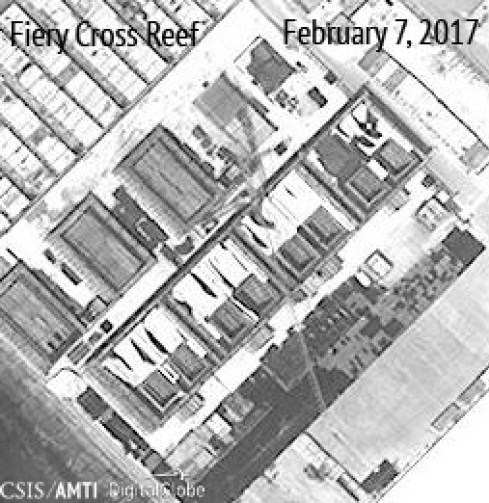
New satellite images show the Chinese military shoring up its defenses on a disputed island chain in the South China Sea, adding what appears to be reinforced launch sites for surface-to-air missiles on at least three atolls.
The existence of the new launch sites was first reported by Reuters on Wednesday, and on Thursday, photos of the nearly completed structures were obtained by the Center for Strategic and International Studies (CSIS). The images show at least eight structures on three of China’s man-made atolls in the Spratly Islands: Fiery Cross, Mischief Reef and Subi Reef.
A U.S. defense official, speaking on the condition of anonymity to discuss intelligence matters, said Wednesday that the buildings have retractable roofs, making them suitable launching points for medium- to long-range surface-to-air missile systems.
According to a photo analysis by CSIS, the buildings are about 66 feet long and 33 feet wide, making them large enough to store China’s HQ-9 missile system. The HQ-9 closely resembles Russia’s S-300, a surface-to-air missile system with a range of approximately 93 miles and an ability to hit targets flying at 88,000 feet. It is unclear, however, whether the actual HQ-9 launchers have been deployed to the Spratlys, as one of the benefits of the new launch structures is the ability to conceal them from reconnaissance flights and satellites.
Chinese foreign ministry spokesman Geng Shuang didn’t deny the existence of the launch sites at a Wednesday briefing with reporters.

“China has indisputable sovereignty of the South China Sea islands and their adjacent water,” he said. “China will uphold its territorial sovereignty and maritime rights and interests. At the same time, we are committed to peacefully resolve relevant disputes through negotiation and consultation with countries directly concerned and are committed to working together with ASEAN countries to maintain peace and stability on the South China Sea. China has the right to deploy necessary defenses facilities as appropriate on its own territory.”
The HQ-9s on the Spratlys would be a significant improvement to the island chain’s defenses. In December, satellite imagery showed that the Chinese military had built a structure that contained antiaircraft guns and potentially close-in weapons systems, or CWIS. Often found on U.S. ships and installations, CWIS is a network of weapons that tracks and destroys incoming missiles. Both the CWIS and anti-aircraft guns, however, are limited in range compared to the HQ-9s’ ability to track and hit targets beyond the horizon.
Last year, China deployed HQ-9s to the Parcel Islands, a cluster of similar man-made atolls north of the Spratlys and near the coast of Vietnam. In February 2016, an HQ-9 battery was observed on the Parcel’s Woody Island, but by July the missiles had been withdrawn. Woody Island also reportedly is home to Chinese YJ-62 anti-ship cruise missiles.
China has long claimed that the South China Sea’s resource-rich waters and its tiny atolls are sovereign Chinese territory, but many of the islands also have been claimed by multiple other countries, including Taiwan, Vietnam and the Philippines. The U.S. military, in support of its regional allies, has contested Chinese claims in the form of what the Pentagon calls “Freedom of Navigation Operations.” Over the weekend, the USS Carl Vinson, a Nimitz-class aircraft carrier, began operations in the South China Sea without incident.
It is unclear how President Donald Trump will react to China’s continued militarization in the South China Sea.
(c) 2017, The Washington Post · Thomas Gibbons-Neff

